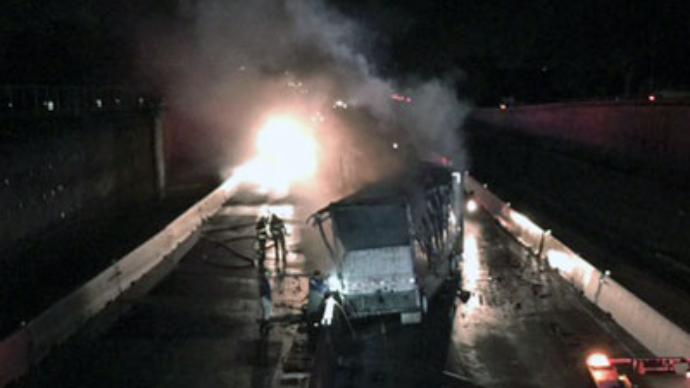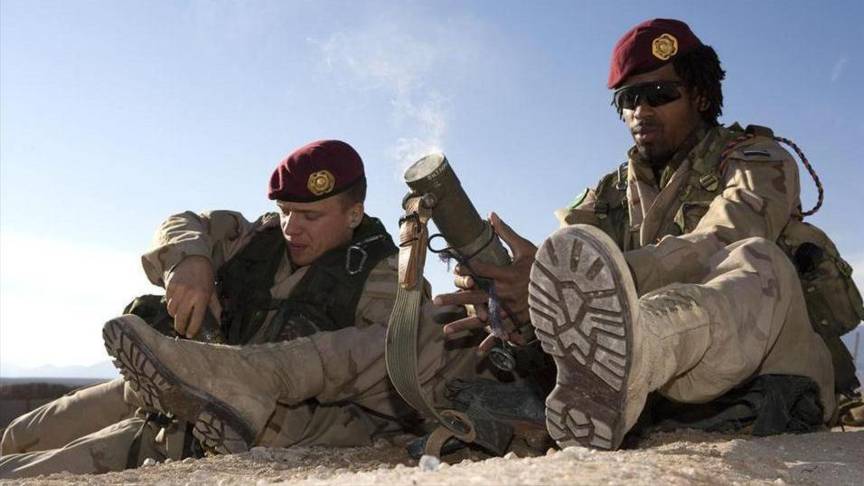Accident Reporting February - July 2016
Explosion in Port of Antwerpen, Belgium (February 26, 2016)
“A heavy blast rocked the port of Antwerp on Friday when a solid waste storage bunker exploded at an industrial waste treatment plant, Antwerp’s fire department said. The blast originated in a tank containing solvents, while an adjacent warehouse, containing small quantities of stored chemicals, caught fire and burned down completely, the facility owner Indaver said.
There were no injuries reported, however due to the heavy smoke billowing from the port, local residents were asked to remain indoors and close their windows to avoid inhaling potential contaminants emitted from the blast.
Firefighters were rushed to the scene and managed to extinguish the fire by early evening, the Port of Antwerp told World Maritime News. Based on the latest update, an investigation into the level of toxicity from the blast showed that the concentration was not dangerous for human health. Indaver said on Monday that the activities at the facility have partially been resumed today with workers launching an investigation into the accident.”
http://worldmaritimenews.com/archives/184170/antwerp-port-hit-by-heavy-explosion/
https://www.youtube.com/watch?v=lIZwyuXQisw
https://www.youtube.com/watch?v=jpBDLEFBxxI
Explosion at military plant in Webster Parish, Louisiana, US (February 7, 2016)
“An explosion at an ArkLaTex military plant has left it closed Tuesday morning.
It happened at the valentec plant in Webster Parish at about 5:30 Monday afternoon. Firefighters, deputies and military personnel say they dealt with the fire from that explosion at the valentec plant, into Tuesday morning. Four miles away was the closest news crews could get to the blast on Monday.The blast happened while the company was making military flares. No one was injured during the explosion. The company evacuated many of it's workers. Smoke from the explosion could be seen as far away as Shreveport. Witnesses say at first, the explosion looked like a dark yellow cloud.”
http://www.ksla.com/story/5281639/explosion-rocks-army-ammunition-plant
Crash involving rig hauling ammo in Salado, Texas, US (March 24, 2016)
Rounds detonated early Thursday after an 18-wheeler hauling ammunition was involved in a fiery crash with another rig on Interstate 35 in Salado, closing the northbound and southbound lanes for hours.

Trucks after the explosions
The FedEx twin-trailer truck collided with another 18-wheeler at around 2 a.m. Thursday at mile marker 285 and caught fire. Because of the accident and the hazard posed by the fire and the cargo, northbound and southbound traffic was diverted off the highway until around 9:30 a.m. and the northbound lanes remained closed until around 10:30 a.m. Details of how the crash happened weren’t immediately available. No one was seriously injured.”
Ammo dump fire in Pulgaon, India (May 31, 2016)
“Around 20 people, including an officer of the rank of Lt Colonel, were killed and several injured in a major fire in India's biggest ammunition depot located in Pulgaon, 110 km from Nagpur in Maharashtra. Catering to Army's ammunition needs in the western sector, Pulgaon is home to the biggest stockpile of weapons including Brahmos missiles.
The fire, at the depot in Wardha district is now said to be limited to a small area and several surrounding villages have been evacuated with a Court of Inquiry ordered by the Army Chief, General Dalbir Singh Suhag. Quoting an Army officer, PTI reported that "secondary fire and explosions cannot be ruled out now". Television footage showed massive flames lighting up the night sky at Pulgaon where the central ammunition depot is located.
The blaze triggered multiple explosions, rocking houses in the area and forcing the evacuation of more than 1,000 people. Two among the 20 dead were identified as Lt Col RS Pawar and Major K Manoj. The dead and injured soldiers belonged to the Defence Security Corp (DSC) that guards strategic defence installations.
Defence minister Manohar Parrikar is slated to visit Pulgaon this afternoon. Incidentally, Parikkar was in Pune to meet villagers around another ammunition depot in Pimpri and Chinchwad. The villagers have been demanding that the sanitised area around the dump be reduced to allow them to build houses. In recent years, there have been several fires at ammunition depots with the last one in West Bengal's Panagarh which is also an IAF base, which was rocked by explosions in 2010.
In 2007, thousands of villagers living in Kashmir's Anantnag district were evacuated after a huge fire broke out at a depot, injuring at least 25 people.
But, it was a fire in 2000 at an ammunition depot in Bharatpur in Rajasthan that put our attention back on the handling of ammunition and the safety of civilians around such locations. However, in recent years the defence ministry has been under immense pressure from local politicians to relax norms on no-go-areas around these ammunition depots.
According to the Works of Defence Act 1903, the ministry of defence can issue notification for sensitive defence establishments, putting restrictions on construction activities carried out by civilians in a certain radius for safety reasons in case of accidents.
An article in The Indian Express on 17 May quoted Lok Sabha MP from Shirur, Shivajirao Adhalrao Patil, who raised the issue of Red Zone limits around Dighi Magazine Depot in the assembly claiming that the defence minister was positive about reducing the Outer Safety Distance (OSD) from 1,145 metres to 500 metres, but there was resistance from ministry officials.
Local people have demanded a reduction in the 2,000-yard limit of the Red Zone around Dehu Road ammunition depot and Dighi magazine depot as several people are living around these areas. Parikkar travelled to Pune on Tuesday to discuss the issue with local people when the Pulgaon ammunition dump caught fire.
While the Court of Inquiry will conduct a thorough investigation into the cause of this fire serious questions are being raised about the security of civilians in surrounding areas. Coinciding with demands from residents of Pimpri and Chinchwad, an IAF ammunition depot in Gurgaon was also in news for similar demands.
Encroachments, with the complicity of local administration, have created a major security hazard around the Gurgaon IAF depot. Attempts to demolish tenements hugging the outer walls of the IAF depot faced strong protests as local politicians demanded demanding that norms be relaxed at the cost of safety of civilian population living around.
The IAF could not get the surrounding areas vacated and the matter went to the courts.
In March this year, the Punjab and Haryana High Court directed the deputy commissioners (DCs) of Gurgaon and Faridabad to issue notices against those who have made constructions within 300 metre around the IAF ammunition depot Gurgaon and 100-metre around the air forces station in Faridabad.
The state government is in talks with private builders to provide alternate housing to people living near the IAF ammunition depot. The decision comes after Punjab and Haryana high court directed the Khattar government to remove all structures that lie within 300 metres of the depot.
The Hindu reported from the IAF ammunition in Gurgaon in February 2016: "surrounded by unauthorised buildings, security of 54 Air Stores Park, Air Force Station Ammunition Depot on Old Delhi-Gurgaon Road, could be a major concern for the authorities. Though no construction is allowed in a 900 meter radius around the IAF ammunition depot, houses - most of them with a second floor - rise above the concertina mesh on the depot's boundary wall. Though crucial for the IAF because of its strategic location near Delhi, the political patronage and a mix of civic indifference and collusion has allowed houses to be built deep inside the restricted zone of the depot."
Takata airbag recall, US (2016 and ongoing)
“Vehicles made by 14 different automakers have been recalled to replace frontal airbags on the driver’s side or passenger’s side, or both in what NHTSA has called "the largest and most complex safety recall in U.S. history." The airbags, made by major parts supplier Takata, were mostly installed in cars from model year 2002 through 2015. Some of those airbags could deploy explosively, injuring or even killing car occupants. (Look for details below on waits for replacement airbags.)
At the heart of the problem is the airbag’s inflator, a metal cartridge loaded with propellant wafers, which in some cases has ignited with explosive force. If the inflator housing ruptures in a crash, metal shards from the airbag can be sprayed throughout the passenger cabin—a potentially disastrous outcome from a supposedly life-saving device.
NHTSA has determined the root cause of the problem: airbags that use ammonium nitrate-based propellent without a chemical drying agent. As postulated early on, environmental moisture, high temperatures, and age as associated with the defect that can improperly inflate the airbags and even send shrapnel into the occupant. To date, there have been 10 deaths and more than 100 injuries due to this problem in the U.S.
Through various announcements, the recall has tripled in size over the past year. It currently stands at more than 100 million vehicles worldwide with airbag inflators needing to be replaced before 2019.
The safety agency has not yet announced the vehicles that are included in the expansion. NHTSA will consult the affected automakers to determine a rollout schedule for the recall, prioritizing the highest-risk vehicles.”
Accident with 60 mm mortar in Mali (July 6, 2016)
Due to an accident with a 60 mm mortar in Mali, two soldiers of the Dutch Airmobile Brigade died and one got severely injured. The portable 60 mm mortars are mainly used for training and preparation of missions. The type of mortar used is the French Hotchkiss-Brandt, which was rebuilt/adapted end of the seventies. The cause of the accident is currently being investigated by the Dutch Marechaussee.
http://www.nu.nl/politiek/4289711/gebruik-type-mortier-opgeschort-ongeluk-mali-.html
Accidents with mortars can take place due to material failure or human error. Problems with fuzes and energetic material may lead to in-bore detonation or early prematures. Newer fuzes are more safe and do not arm inside the tubes. Barrel and firing pin fouling can also play a role, resulting in cartridges sticking to the bore. Double feeding (loading a second mortar round before the first one got out) can lead to an in-bore detonation as well. Presence of people in the target area /firing line can contribute to the consequences of the accident. One of the most catastrophic accidents with 60 mm mortars happened in Nevada in March 2013, where 7 marines died, and 7 got injured.
https://www.youtube.com/watch?v=ak_L2cpyGZA
https://www.youtube.com/watch?v=Wq3z30QHl2s
MSIAC members with access to MAD-X (MSIAC Accident Database eXchange) have access to a more detailed description of earlier mortar accidents.

Dutch military with 60 mm mortar in Afghanistan (source: www.nos.nl)


